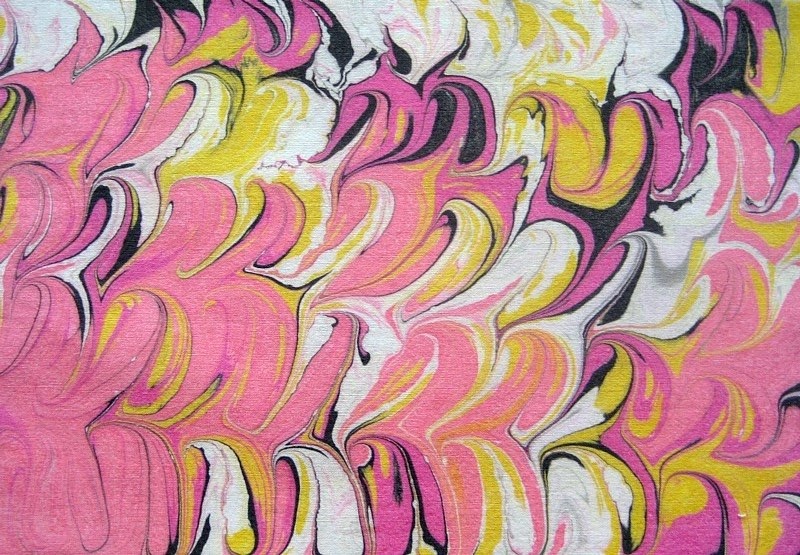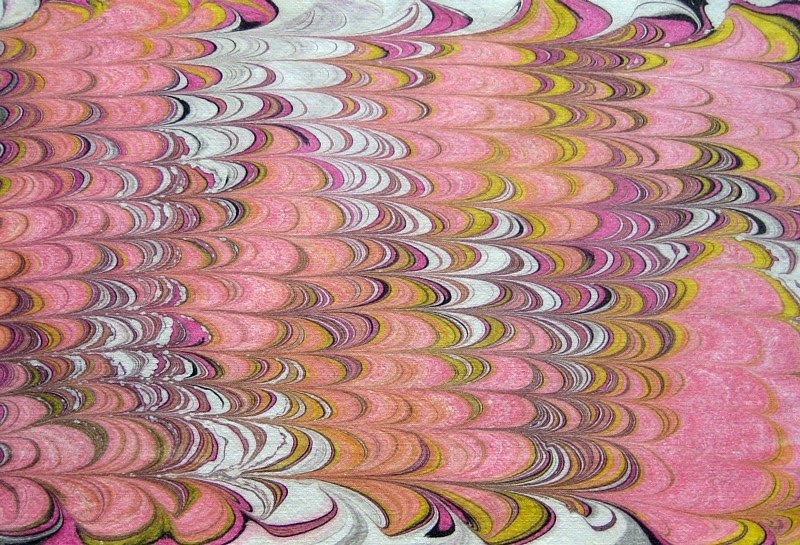I've written about marbling once before, here, when I first tried marbling with wallpaper paste as the base, or size as it's called. The results were quite pleasing, but not what I had expected, as the paints didn't behave the way I wanted them to. In traditional marbling, the paints float out on the surface of the size and you can build patterns with circles within circles. Not so with the wallpaper paste.
About a month ago I started experimenting again with the technique, and with different mediums. In many instructions carrageenan (a seaweed derivative also used in the food industry) is recommended for the size, but since that is difficult to find in Finland, I decided to try wallpaper paste again, as well as a size made from potato flour. I had mixed success.
The problem I had with wallpaper paste is that it was very difficult to get the right consistency. If it was thin the paints sank, and if it was thick the paints just sat on the surface like scared little rabbits. A common advice is to thin the paint if it sinks, but I found that with wallpaper paste it didn't make much difference. In fact, the paint seemed to sink even faster when I thinned it. And the point is: you can't thin paint in absurdum, because you'll just get weak paint - weak colour and weak bonding to the fabric. My conclusion, for now, as for wallpaper paste, is that it works well if it's thick enough to carry the paint (I used 10 g of Kiilto Wall Eco glue powder to 5 dl water, but different brands may vary so you will have to experiment), and if you don't mind that the paint sits on the surface instead of spreading out. You'll just have to work the paint a little more to get patterns, and the patterns will be a little different from the ones you get in traditional marbling. Please refer to my earlier blog entry for images.
A size made from potato flour (I mixed a small amount of potato flour (1 tbs) in water (5 dl) and heated it to simmering point to thicken the mix) worked better than wallpaper paste. In fact, the paints spread exactly the way I wanted them to. The problem, however, is that a size made from potato flour can be quite uneven, the consistency changes with time and a skin forms. Also, if you don't get the right consistency straight away, there's not much you can do about it. You'll just have to cook a new mix and wait for the size to cool. My conclusion is that a size from potato flour and water works for traditional marbling, but it is unpredictable and difficult to adjust. I'm not sure I'll bother with it again... Especially since...
... I was on the brink of giving up when I found - drum roll - Deka Marble Medium.
Deka Marble Medium (which I suspect might be carrageenan, but it doesn't say so) does what it is supposed to do. It is easy to mix, and it holds the paints. If it's too thick you can add some water to it, and if it's too thin, you can thicken it with more medium. The consistency is crucial, and it may vary with different paints, so don't be discouraged if the paints sink at first. Here's some advice:
The first time I tried the medium, I weighed the powder (10 g to 2 L of water) and it worked like a charm. The second time I measured the powder with a teaspoon according to the instructions (2 tsp to 2 L of water). That didn't work at all. The paint which worked so well before sank like a rock no matter how much I thinned it. So the third time I measured the spoons with the help of my scales and discovered that 2 tsp was less than 8 g. So the right amount is more like 2.5 tsp to 2 L.
Another interesting thing I discovered was that if the Deka Marble Medium is too thick, the paints might also sink. The third time I made the size a little bit thicker (11 g powder to 2 L) for the sake of the experiment, and to my astonishment, the paint which had worked fine before sank. I then added 0.5 dl of water to the size and the paint was fine again. So, the lesson learned is that marbling is an art form that you don't learn in one sitting, but with a bit of patience and understanding (i.e. experience) of the medium and paints, you will succeed. In my next blog entry I'll write about paints. Here are some images of my work space and favourite samples:
Work in progress
Drying area
Favourite samples
Thanks for visiting my blog! More to follow soon!
- Annika






Vilka vackra tyger ! Om det är tyg.
ReplyDeletemor
Tack Mor! :-) Jepp, det är tyger.
DeleteWow!!! I love the results! Marbling is one of those things I have always wanted to try, but never have made the time. Your results really have got the wheels spinning here and as soon as I can set up the outdoor wet studio, I'll have to try it. Thanks for all you insight. I think this is the year I buy a scale. Dyers seem to get better results when they weigh the dye powder and it seems to have a benefit in most media. Have a wonderful week! (Are you still thinking of moving?)
ReplyDeleteCiao Annika! Snubblade in här när jag sökte på marmorering. Jag marmorerade papper med strålande resultat för ca 20 år sen, men minns ej alls vilken metod jag använde. Spädde ut oljefärger, ev.? Nu har jag just köpt en massa Dekafärger på -50 % på Tempera plus deras marble medium. Can't wait! Utmärkta tips här, ska använda dem.
ReplyDeleteH. Sanna
Hej Sanna! Tack för kommentaren! Kul om mina tips är till nytta. Lycka till med marmorerandet! :-)
ReplyDelete